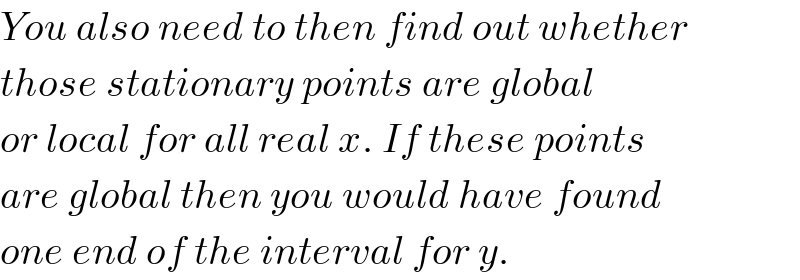
Previous in Relation and Functions Next in Relation and Functions
Question Number 5237 by sanusihammed last updated on 02/May/16

$${find}\:{the}\:{domain}\:{and}\:{range}\:{of}\: \\ $$ $${y}\:=\:\left[_{\:\mathrm{4}{x}^{\mathrm{2}} +\mathrm{3}\:\:\:\:\:\:\:\:\:\:\:\:\:\:\:{x}\:<\mathrm{2}} ^{\:\mathrm{3}{x}−\mathrm{1}\:\:\:\:\:\:\:\:\:\:\:\:\:\:\:\:{x}\:\geqslant\:\mathrm{2}} \right. \\ $$
Answered by FilupSmith last updated on 02/May/16
![Domain = {x: −∞≤x≤∞} Range_1 y=3x−1 {y: [3(2)−1]≤y≤∞} {y: 5≤y≤∞} Range_2 y=4x^2 +3 {y: −∞≤y<[4(2)^2 +3]} {y: −∞≤y<19} ∴Range = {y: −∞≤y≤∞}](Q5239.png)
$${Domain}\:=\:\left\{{x}:\:−\infty\leqslant{x}\leqslant\infty\right\} \\ $$ $$ \\ $$ $${Range}_{\mathrm{1}} \:{y}=\mathrm{3}{x}−\mathrm{1} \\ $$ $$\left\{{y}:\:\left[\mathrm{3}\left(\mathrm{2}\right)−\mathrm{1}\right]\leqslant{y}\leqslant\infty\right\} \\ $$ $$\left\{{y}:\:\mathrm{5}\leqslant{y}\leqslant\infty\right\} \\ $$ $$ \\ $$ $${Range}_{\mathrm{2}} \:{y}=\mathrm{4}{x}^{\mathrm{2}} +\mathrm{3} \\ $$ $$\left\{{y}:\:−\infty\leqslant{y}<\left[\mathrm{4}\left(\mathrm{2}\right)^{\mathrm{2}} +\mathrm{3}\right]\right\} \\ $$ $$\left\{{y}:\:−\infty\leqslant{y}<\mathrm{19}\right\} \\ $$ $$ \\ $$ $$\therefore{Range}\:=\:\left\{{y}:\:−\infty\leqslant{y}\leqslant\infty\right\} \\ $$
Answered by Rasheed Soomro last updated on 02/May/16

$${y}\:=\:\left[_{\:\mathrm{4}{x}^{\mathrm{2}} +\mathrm{3}\:\:\:\:\:\:\:\:\:\:\:\:\:\:\:{x}\:<\mathrm{2}} ^{\:\mathrm{3}{x}−\mathrm{1}\:\:\:\:\:\:\:\:\:\:\:\:\:\:\:\:{x}\:\geqslant\:\mathrm{2}} \right. \\ $$ $$\mathrm{The}\:\mathrm{function}\:\mathrm{is}\:\mathrm{defined}\:\mathrm{for}\:\mathrm{all}\:\mathrm{real} \\ $$ $$\mathrm{numbers}.\:\mathrm{Hence}\:\mathrm{domain}\:\mathrm{of}\:\mathrm{function}\: \\ $$ $$\mathrm{is}\:\mathbb{R}. \\ $$ $$\:^{\bullet} \mathrm{For}\:\mathrm{x}\geqslant\mathrm{2} \\ $$ $$\:\:\:\:\:\:\:\:\:\:\mathrm{x}\geqslant\mathrm{2} \\ $$ $$\:\:\:\:\:\Rightarrow\mathrm{3x}\geqslant\mathrm{6} \\ $$ $$\:\:\:\:\:\Rightarrow\mathrm{3x}−\mathrm{1}\geqslant\mathrm{5} \\ $$ $$\:\:\:\:\:\Rightarrow\:\mathrm{y}\geqslant\mathrm{5} \\ $$ $$\:^{\bullet\:} \mathrm{For}\:\mathrm{x}<\mathrm{2} \\ $$ $$\:\:\:\:\:\:\:\:\:\:\mathrm{x}<\mathrm{2} \\ $$ $$\:\:\:\:\:\Rightarrow\mathrm{x}^{\mathrm{2}} <\mathrm{4} \\ $$ $$\:\:\:\:\:\Rightarrow\mathrm{4x}^{\mathrm{2}} <\mathrm{16} \\ $$ $$\:\:\:\:\:\Rightarrow\mathrm{4x}^{\mathrm{2}} +\mathrm{3}<\mathrm{19} \\ $$ $$\:\:\:\:\:\Rightarrow\:\mathrm{y}<\mathrm{19} \\ $$ $$\mathrm{So}\:\mathrm{the}\:\mathrm{range}\:\mathrm{is}\:\left\{\mathrm{y}\:\mid\:\mathrm{y}\in\:\mathbb{R}\:\wedge\:\:\mathrm{5}\leqslant\mathrm{y}<\mathrm{19}\:\right\} \\ $$
Commented byYozzii last updated on 02/May/16

$${y}\geqslant\mathrm{3}.\:{Do}\:{a}\:{sketch}\:{graph}\:{for}\:{y}\:{to}\:{see} \\ $$ $${this}. \\ $$
Commented byFilupSmith last updated on 02/May/16

$${Ah}\:{i}\:{miswrote}\:{the}\:{final}\:{part}! \\ $$
Commented byRasheed Soomro last updated on 06/May/16

$$\mathrm{From}\:\mathrm{graph}\:\mathrm{I}\:\mathrm{understand}\:\mathrm{now}\:\mathrm{that}\:\mathrm{the}\:\mathrm{range}\:\mathrm{is}\:\left\{{y}:\:{y}\in\mathbb{R},{y}\geqslant\mathrm{3}\right\} \\ $$ $$\mathrm{Credit}\:\mathrm{goes}\:\mathrm{to}\:\mathrm{Yozzi}. \\ $$ $$\mathrm{I}\:\mathrm{think}\:\mathrm{that}\:\mathrm{for}\:\mathrm{determining}\:\mathrm{range}\:\mathrm{of}\: \\ $$ $$\mathrm{a}\:\mathrm{function}\:\mathrm{its}\:\mathrm{minima}\:\mathrm{and}\:\mathrm{maxima}\:\mathrm{should} \\ $$ $$\mathrm{be}\:\mathrm{considered}. \\ $$
Commented byRasheed Soomro last updated on 05/May/16

Commented byYozzii last updated on 06/May/16

$${You}\:{also}\:{need}\:{to}\:{then}\:{find}\:{out}\:{whether} \\ $$ $${those}\:{stationary}\:{points}\:{are}\:{global} \\ $$ $${or}\:{local}\:{for}\:{all}\:{real}\:{x}.\:{If}\:{these}\:{points} \\ $$ $${are}\:{global}\:{then}\:{you}\:{would}\:{have}\:{found} \\ $$ $${one}\:{end}\:{of}\:{the}\:{interval}\:{for}\:{y}. \\ $$
